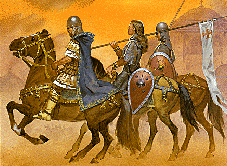|
The alpha female in history |
|
Historical
Reality?
We'll never know it. We're
stuck with the story of the past, not the history and historically men
have recorded history. More recently, both men and women of
the media, have written the story. However, thanks to womeninworldhistory.com, we have a compendium of short histories of women who have been international world leaders...below. |
The sisters
were daughters of a powerful lord. Trung Trac was the elder; Trung Nhi,
her constant companion, the younger. They lived in a time when
Vietnamese women enjoyed freedoms forbidden them in later centuries. For
example, women could inherit property through their mother's line and
become political leaders, judges, traders, and warriors. Trung Trac was
married to Thi Sach, another powerful lord. Chinese records note that
Trac had a "brave and fearless disposition." It was she who
mobilized the Vietnamese lords to rebel against the Chinese. Legend says
that to gain the confidence of the people, the Trung sisters committed
acts of bravery, such as killing a fearful people-eating tiger - and
used the tiger's skin as paper to write a proclamation urging the people
to follow them against the Chinese. The Trungs
gathered an army of 80,000 people to help drive the Chinese from their
lands. From among those who came forward to fight the Chinese, the Trung
sisters chose thirty-six women, including their mother. They trained
them to be generals. Many names of leaders of the uprising recorded in
temples dedicated to Trung Trac are women. These women led a people's
army of 80,000 which drove the Chinese out of Viet Nam in 40 A.D. The
Trung sisters, of whom Nhi proved to be the better warrior, liberated
six-five fortresses. After their
victory, the people proclaimed Trung Trac to be their ruler. They
renamed her "Trung Vuong" or "She-king Trung." She
established her royal court in Me-linh, an ancient political center in
the Hong River plain. As queen she abolished the hated tribute taxes
which had been imposed by the Chinese. She also attempted to restore a
simpler form of government more in line with traditional Vietnamese
values. For the next
three years the Trung sisters engaged in constant battles with the
Chinese government in Vietnam. Out armed, their troops were badly
defeated in 43 A.D. Rather than accept defeat, popular lore says that
both Trung sisters chose the traditional Vietnamese way of maintaining
honor - they committed suicide. Some stories say they drowned themselves
in a river; others claim they disappeared into the clouds. Over time the
Trungs became the stuff of legends and poems and a source of pride for
women who lived more restricted lives. Today, stories, poems,plays,
postage stamps, posters and monuments still glorify the heroism of the
Trung sisters. "All
the male heroes bowed their heads in submission;
The
Tang dynasty (618-906 AD) was a time of relative freedom for women. They
did not bind their feet nor lead submissive lives. It was a time in
which a number of exceptional women contributed in the areas of culture
and politics. So it is no surprise that Wu, born into a rich and noble
family, was taught to play music, write, and read the Chinese classics.
By thirteen years of age she was known for her wit, intelligence, and
beauty, and was recruited to the court of Emperor Tai Tsung. She soon
became his favorite concubine. But she also had eyes for his son, Kao
Tsung. When the
emperor died and Kao Tsung took over, Wu was now twenty seven years old.
In time she became a favorite concubine of the new emperor, giving birth
to the sons he wanted. As mother of the future emperor of China, she
grew in power. She managed to eliminate Kao Tsung's wife, Empress Wang,
by accusing her of killing Wu's newborn daughter. Kao Tsung believed Wu,
and replaced Empress Wang to marry the up and coming Wu Zetian. Within five
years of their marriage, Emperor Kao Tsung suffered a crippling stroke.
The Empress Wu took over the administrative duties of the court, a
position equal to the emperor. She created a secret police force to spy
on her opposition, and cruelly jailed or killed anyone who stood in her
way, including the unfortunate Empress Wang. With the death of Emperor
Kao Tsung, Wu managed to outflank her eldest sons and moved her
youngest, and much weaker son, into power. She in effect ruled, telling
him what to do. In order to
challenge Confucian beliefs against rule by women, Wu began a campaign
to elevate the position of women. She had scholars write biographies of
famous women, and raised the position of her mother's clan by giving her
relatives high political posts. She moved her court away from the seat
of traditional male power and tried to establish a new dynasty. She said
that the ideal ruler was one who ruled like a mother does over her
children. In 690, Wu's
youngest son removed himself from office, and Wu Zetian was declared
emperor of China. In spite of her ruthless climb to power, her rule
proved to be benign. She found the best people she could to run the
government, and treated those she trusted fairly. She reduced the army's
size and stopped the influence of aristocratic military men on
government by replacing them with scholars. Everyone had to compete for
government positions by taking exams, thus setting the practice of
government run by scholars. Wu also was fair to peasants, lowering
oppressive taxes, raising agricultural production, and strengthening
public works. During her
reign, Empress Wu placed Buddhism over Daoism as the favored state
religion. She invited the most gifted scholars to China and built
Buddhist temples and cave sculptures. Chinese Buddhism achieved its
highest development under the reign of Wu Zetian. As
she grew older, Empress Wu lessened the power of her secret police.
But she become increasingly superstitious and fearful. Sorcerers and
corrupt court favorites flattered her. Finally, in 705, she was
pressured to give up the throne in favor of her third son, who was
waiting all these years in the wings. Wu Zetian died peacefully at age
eighty the same year.
Her father was the king of the Silla kingdom, which had emerged in the south about 250 and 350 AD, and by the end of the 7th century would manage to unify the whole peninsula. Having no sons, he chose as his heir his daughter Sondok, which was no great surprise for a number of reasons. One was that women in this period had a certain degree of influence already as advisers, queen dowagers, and regents. Throughout the kingdom, women were heads of families since matrilineal lines of descent existed alongside patrilineal lines. The Confucian model, which placed women in a subordinate position within the family, was not to have a major impact in Korea until the fifteenth century. During the Silla kingdom, women's status remained relatively high. There were
other reasons, too, that led the king to favor Sondok. Early in her life
she had displayed an unusually quick mind. One anecdote tells of the
time the king received a box of peony seeds from China accompanied by a
painting of what the flowers looked like. Looking at the picture, seven
year old Sondok remarked that while the flower was pretty it was too bad
that it did not smell. "If it did, there would be butterflies and
bees around the flower in the painting." Her observation about the
peonies lack of smell proved correct, one illustration among many of her
intelligence, and thus ability to rule. In 634, Sondok
became the sole ruler of Silla, and ruled until 647. She was the first
of three females rulers of the kingdom, and was immediately secceeded by
her cousin Chindok, who ruled until 654. Sondok's reign
was a violent one; rebellions and fighting in the neighboring kingdom of
Paekche filled her days. Yet, in her fourteen years as queen of Korea,
her wit was to her advantage. She kept the kingdom together and extended
its ties to China, sending scholars to learn from that august kingdom.
Like China's Empress
Wu
Zetian, she was drawn to Buddhism and presided over the completion
of Buddhist temples. She built the "Tower of the Moon and
Stars," considered the first observatory in the Far East. The tower
still stands in the old Silla capital city of Kyongju, South Korea.
Mirabai
belonged to the Rajput aristocracy. From an early age, she worshiped the
image of Krishna. Her form of worship was influenced by a number of her
male relatives who were devotees of a mystical form of Hinduism called
Bhakti. In the Bhakti tradition, one approached one's god through pure
love, without any restrictions of caste, color, or gender. Many Bhakti
followers gave up their worldly life and left their families to became
wandering teachers or live together in like-minded communities. Their
message usually was spread through deeply personal poems through which
they conversed with their chosen God. Female devotees who aspired to
live this life also had to give up their husbands and family. They had
to live among people from a variety of castes, including those
considered forbidden to them. In spite of what many felt were acts of
subversive, some who overcame obstacles to follow their spiritual quests
in time became respected and even revered. In 1516 Mirabai
was married to Prince Bhoj Raj of the Rajput kingdom of Mewar, the most
powerful Rajput state in the early 16th century. It's capital was
Chittor. From the start Mira was a problem. She refused to worship her
husband's family's goddess (devi), claiming that she already had offered
herself to Lord Krishna and considered herself married to him. She
refused the family's gifts of silks and jewels. She insisting on
associating with the community of bhaktas. And when her husband died
after only three short years, Mirabai refused to join him on his funeral
pyre, a practice at the time expected of high caste Rajput widows.
Instead she claimed that now she was free to devote herself completely
to the worship of Krishna. Mira's
devotional practices became increasingly intense. She often sang and
danced herself into ecstasies, even in public places like temples. News
about her spread all over India and she soon attracted a following of
devotees from all social groups and castes. Mira lived in a
time and place when the sexual virtue of women was fiercely guarded. Her
husband's family was shocked by her actions and finally locked her
inside the house. In her songs Mira says that on two occasions they
tried to kill her, but she was miraculously saved both times. At some
point she left the palace and city of Chittor and returned to her birth
family. They too disapproved of her actions. Sometime around 1527 she
set off as a wanderer, traveling to places of pilgrimage associated with
the life of Krishna. Her popularity grew. Before she even arrived at the
site, people gathered singing her songs. Mirabai returned once briefly
to her home, but in the face of further family harassment decided to
leave the kingdom of Chittor for good. She passed her last days in
Dwarka on the coast of the Arabian sea, the site believed to be that of
Krishna's youth. Mira's
life resonates in the hearts of many in India today for many reasons.
First there are her words, which with beauty and joy express a kind of
female liberation. In them, her rejection and even disdain of the
wealthy and their life of riches also appeals to the poor. Then there
is her rebellion, which is seen as being against injustice within the
family and within kinships groups in general. While valuing women as
mothers above all, India also reveres the self-expression of Mira, a
childless woman who is identified as having rebelled against her
husband and in-laws.
Nur Jahan was
born into an aristocratic Persian family who had immigrated to India.
She was married at age seventeen to a Persian soldier who had a much
admired military career. Upon later siding with the emperor's enemies,
he was executed, leaving Nur a widow with a young daughter called Ladli.
In 1607 Nur Jahan was brought to court to serve as a lady-in-waiting to
one of Jahangir's court women. It was here, maybe at the spring festival
of Nauroz in 1611, where Jahangir first set eyes upon her. All reports
say that she was a remarkable beauty and it perhaps is not surprising
that Jahangir married her within two months. He first gave her the title
Nur Mahal which he changed in 1616 to Nur Jahan, or "Light of the
World." At the time of
her marriage Nur Jahan was considered middle aged. She was a widow of a
man who had lost favor with the emperor, and was only one of many other
wives and concubines of the emperor, with whom he had children.Yet
within nine years Nur Jahan acquired all the rights of sovereignty and
government normally due the emperor, becoming virtually in charge of the
whole empire until the emperor died in 1627. The key to her success was
Jahangir's addiction to both drugs and alcohol and his adoration of Nur
Jahan above everyone else in his vast zanana (women's
quarters within the court). Jahangir needed Nur to help maintain his
health and help him rule. Since women
were not suppose to appear face to face with men in court, Nur Jahan
ruled through trusted males. But it was she who approved all orders and
grants of appointment in Jahangir's name, and controlled all promotions
and demotions within the royal government. She took special interest in
the affairs of women, giving them land and dowries for orphan girls. She
had coins struck in her name, collected duties on goods from merchants
who passed though the empire's lands, and traded with Europeans who
brought luxury goods from the continent. Given her ability to obstruct
or facilitate the opening up of both foreign and domestic trade, her
patronage was eagerly sought, and paid for. She herself owned ships
which took pilgrims as well as cargo to Mecca. Her business connections
and wealth grew. Her officers were everywhere. The cosmopolitan city of
Agra, the Mughal capital, grew as a crossroad of commerce. Nur Jahan also
ruled the emperor's vast zanana which housed hundreds of people
including Jahangir's wives, ladies -in-waiting, concubines, servants,
slaves, female guards, spies, entertainers, crafts people, visiting
relatives. eunuchs, and all the children belonging to the women. Nur
greatly influenced the zanana's tastes in cosmetics, fashions,
food, and artistic expression. She spent money lavishly, experimenting
with new perfumes, hair ointments, jewelry, silks, brocades, porcelain,
and cuisine from other lands. Fashions at court, highly influenced by
Persian culture, began to blend into local styles. Women's clothing was
modified to take account of the hot weather. Since Nur came from a line
of poets, she naturally wrote too and encouraged this among the court
women. Poetry contests were held, and favorite female poets from beyond
the court were sometimes sponsored by the queen, such as the Persian
poet Mehri. Both Jahangir
and Nur Jahan were devotees of the elegant and sophisticated Mughal
artistic style, the Taj Mughal being one example. The emperor owned an
admirable collection of exquisite miniature paintings, and together with
Nur constructed beautiful gardens, notably in the court's summer retreat
in Kashmir. Nur used some gardens for official functions; others were
opened up for the populous in general to use. Architecture, too, was an
important imperial activity; some of the mosques, caravasaries and tombs
Nur Jahan had built are visible today. Nur Jahal
enjoyed the height of her power when she was surrounded by loyal men
which included members of her own family. Struggles between Jahangir's
sons for power, however, slowly chipped away at her reign. The ultimate
winner was Jahangir's third son, Shah Jahan, who later built the
beautiful Taj Mahal for his favorite wife, Mumtaz Mahal. By this time
Nur Jahan's influence was weak. Shah Jahan had been allied with Nur
Jahan through most of his father's reign, but when she swung her support
to others he rebelled. An old and trusted general, Mahabat Khan,
disgusted with the direction of court politics, and particularly the
role of a Nur Jahan, joined the rebellion. "Never," he
said," has there been a king so subject to the will of his
wife." Nur's
cleverness could not save her, and upon Shah Jahan's succession to the
crown, he had her confined. Her imprisonment ended her influence at
court, and she spent the last years of her life in exile in Lahore.
Here she spent a quiet time living with her daughter until her own
death in 1645. Her tomb lies in Lahore next to Jahangir's. Both she
had erected along with the gardens that surround them.
Eleanor of Aquitaine was one of the most powerful and fascinating personalities of feudal Europe. At age 15 she married Louis VII, King of France, bringing into the union her vast possessions from the River Loire to the Pyrenees. Only a few years later, at age 19, she knelt in the cathedral of Vézelay before the celebrated Abbé Bernard of Clairvaux offering him thousands of her vassals for the Second Crusade. It was said that Queen Eleanor appeared at Vézelay dressed like an Amazon galloping through the crowds on a white horse, urging them to join the crusades. While the
church may have been pleased to receive her thousand fighting vassals,
they were less happy when they learned that Eleanor, attended by 300 of
her ladies, also planned to go to help "tend the wounded." The presence of
Eleanor, her ladies and wagons of female servants, was criticized by
commentators throughout her adventure. Dressed in armor and carrying
lances, the women never fought. And when they reached the city of
Antioch, Eleanor found herself deep in a renewed friendship with
Raymond, her uncle, who had been appointed prince of the city. Raymond,
only a few years older than Eleanor, was far more interesting and
handsome than Eleanor's husband, Louis. When Raymond decided that the
best strategic objective of the Crusade would be to recapture Edessa,
thus protecting the Western presence in the Holy Land, Eleanor sided
with his view. Louis, however, was fixated on reaching Jerusalem, a less
sound goal. Louis demanded that Eleanor follow him to Jerusalem.
Eleanor, furious, announced to one and all that their marriage was not
valid in the eyes of God, for they were related through some family
connections to an extent prohibited by the Church. Wounded by her claim,
Louis nonetheless forced Eleanor to honor her marriage vows and ride
with him. The expedition did fail, and a defeated Eleanor and Louis
returned to France in separate ships. On her way
home, while resting in Sicily, Eleanor was brought the news that her
fair haired uncle had been killed in battle, and his head delivered to
the Caliph of Baghdad. Although her marriage to Louis continued for a
time, and she bore him two daughters, the relationship was over. In 1152
the marriage was annulled and her vast estates reverted to Eleanor's
control. Within a year, at age thirty, she married twenty year old Henry
who two years later became king of England. In
the papal bull for the next Crusade, it expressly forbade women of all
sorts to join the expedition. All the Christian monarchs, including
King Louis, agreed to this. But by this time Eleanor had problems of
her own in her marriage to King Henry II of England.
Carl Jung and female archetypes. |
"I never realized until lately that women
were supposed to be inferior."
Katharine Hepburn
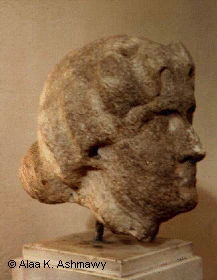
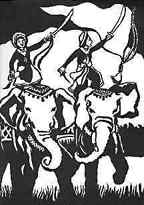
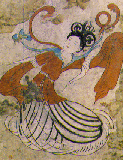 Even though
according to the Confucian beliefs having a woman rule would be as
unnatural as having a "hen crow like a rooster at daybreak,"
during the most glorious years of the Tang dynasty a woman did rule, and
ruled successfully. She was Wu Zetian, the only female in Chinese
history to rule as emperor. To some she was an autocrat, ruthless in her
desire to gain and keep power. To others she, as a woman doing a
"man's job," merely did what she had to do, and acted no
differently than most male emperors of her day. They also note that she
managed to effectively rule China during one of its more peaceful and
culturally diverse periods.
Even though
according to the Confucian beliefs having a woman rule would be as
unnatural as having a "hen crow like a rooster at daybreak,"
during the most glorious years of the Tang dynasty a woman did rule, and
ruled successfully. She was Wu Zetian, the only female in Chinese
history to rule as emperor. To some she was an autocrat, ruthless in her
desire to gain and keep power. To others she, as a woman doing a
"man's job," merely did what she had to do, and acted no
differently than most male emperors of her day. They also note that she
managed to effectively rule China during one of its more peaceful and
culturally diverse periods.
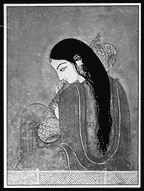
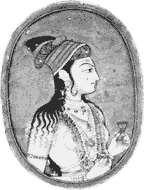 Nur
Jahan was one of the most influential women of her day. As favorite wife
of the powerful Mughal emperor Jahangir, she found herself uniquely
positioned to brilliantly utilize her skills in administration,
politics, economics, and culture.
Nur
Jahan was one of the most influential women of her day. As favorite wife
of the powerful Mughal emperor Jahangir, she found herself uniquely
positioned to brilliantly utilize her skills in administration,
politics, economics, and culture.